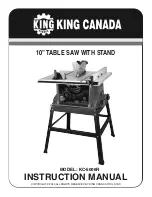
ADJUSTMENTS & OPERATION
RAISING AND TILTING BLADE
The height of the saw blade is adjusted by turning the handwheel (A) Fig.19.
Turning the handwheel clockwise will lower the blade and counterclockwise will
raise the blade. As a general rule, set the blade height 1/8” above the top of your
workpiece. The angle of the saw blade will not be affected by raising or lowering
the saw blade.
The saw blade can be tilted to any degree between 0º and 45º to the left for
angled cuts. The blade angle lock knob (B) Fig.19 locks the tilting mechanism.
Loosen blade angle lock knob, push handwheel (A)
towards the saw so that the
gear ring on the handwheel engages the toothed segment of the saw
housing. Then turn the handwheel until the blade is positioned at the
desired angle.
Retighten angle lock knob once you have obtained the desired
cutting angle.
PUSH STICK CONSTRUCTION
A push stick is supplied with this table saw and should be used whenever
possible. If you loose or misplace the push stick,
Fig.20
shows an illustration of
how to make one yourself. It is recommended to use a good quality plywood or
solid wood, 1/2” and 3/4” thick.
DUST COLLECTION
To control air borne saw dust, it is recommended to connect a dust collection
system or vacuum to one or both dust chutes on this Table Saw.
The blade guard (A) Fig.21 comes with a dust chute (B), which helps remove
dust from the source. A second cabinet dust chute (C) is located at the rear of the
saw, this dust chute will remove the remaining dust which falls below the blade.
If the dust chutes are not used to collect saw dust, cleaning will become much
more important to maintain Table saw in a clean and working order.
STORAGE AREAS
This Table Saw comes with several storage areas for items which are included,
while they are not being used they can be stored under the table.
The rip fence and push stick storage areas are shown in (C) Fig.21. The
aluminum guide storage area is shown in (D) Fig.21. See Fig.22 for the remaining
storage areas.
FIGURE 19
FIGURE 20
FIGURE 21












